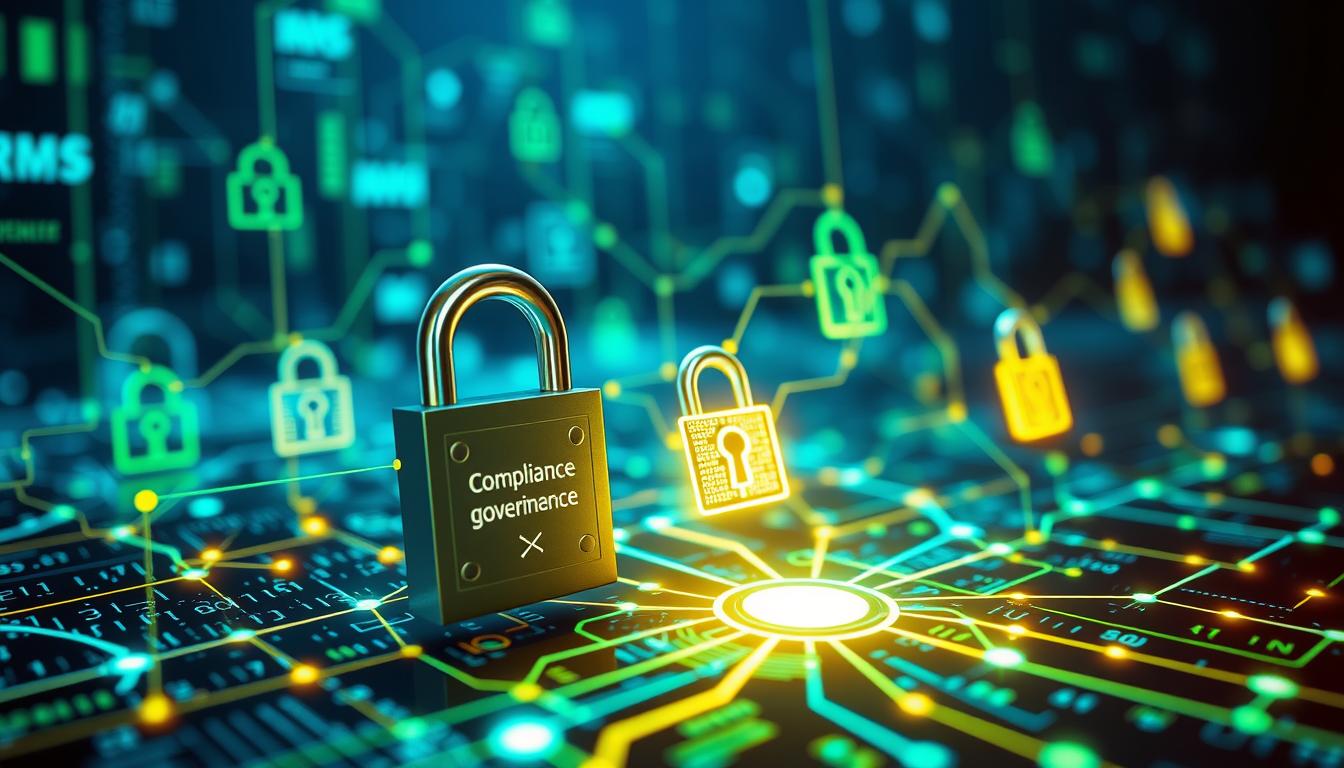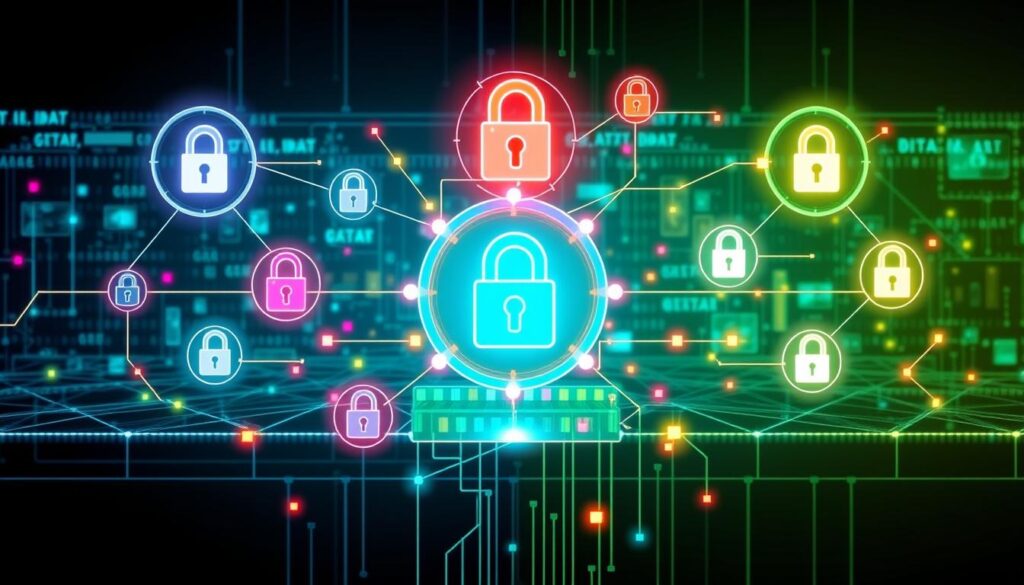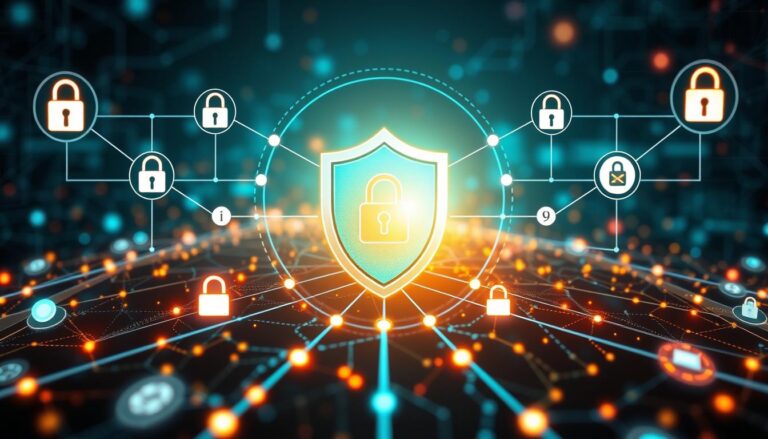
Did you know 90% of organizations struggle with compliance management? This shows how important it is to have a solid plan in today’s digital world. As cyber threats grow, so does the need for better information security governance.
Setting up strong compliance management helps protect your data and builds trust with others. It’s a key part of keeping your information safe.
About 70% of companies use a Governance, Risk Management, and Compliance (GRC) framework. This shows how important it is to link security and compliance strategies. Without clear security policies, around 60% of companies might fail to meet compliance, leading to big fines.
It’s vital to use governance compliance solutions to handle these challenges. This way, you can avoid big risks and keep your data safe.
Putting compliance first helps lower the risk of fines and data breaches. Good governance makes sure your security efforts are more than just following rules. It builds a culture of security awareness and strength.
Understanding Information Security Governance
Information security governance is key to managing cybersecurity in your organization. It sets up cybersecurity policies and defines roles and responsibilities. This framework is vital for handling data safely and ensuring accountability.
It helps protect your organization from threats, keeping it operational and resilient.
Definition and Importance of Governance in Cybersecurity
Information security governance ensures oversight and accountability in cybersecurity practices. It safeguards sensitive information and meets regulatory needs. It also builds trust with customers.
Recent data shows over 80% of organizations aim to improve their cybersecurity maturity due to regulatory pressures. Regular engagement with executives can reduce security breaches by 40%, as studies have shown.
Key Components of an Effective Governance Framework
An effective governance framework has several key components. These ensure strong information security governance. The components include:
- Clear Cybersecurity Policies: Well-defined policies guide organizational behavior and expectations.
- Defined Roles and Responsibilities: Specific roles ensure accountability for security measures.
- Compliance Oversight Mechanisms: Regular audits and assessments measure policy and regulation adherence.
Using automated compliance tools can cut compliance costs by 30%. A governance committee can also align business goals with security strategies. This improves organizational outcomes.
| Component | Description | Impact |
|---|---|---|
| Cybersecurity Policies | Clearly outline acceptable behavior regarding data management. | Enhances organizational compliance and accountability. |
| Defined Roles | Establish specific responsibilities for security practices. | Promotes ownership and accountability across teams. |
| Compliance Oversight | Implement regular audits and assessments. | Ensures adherence to a governance framework. |
The Role of Compliance Management in Security Governance
Compliance management is key for organizations wanting to improve their security governance. It helps protect sensitive information and builds trust with stakeholders. By following laws and regulations, companies show they care about customer data, boosting their reputation.
Importance of Compliance in Building Trust and Reputation
Investing in compliance management brings many benefits. It creates a strong bond between businesses and their customers. Effective compliance shows an organization values data security and follows the law. This leads to:
- Data-driven decision making: Companies with good compliance can handle risks quickly.
- Enhanced customer retention: Strong compliance can help keep customers, reducing loss by up to 25%.
- Financial benefits: Studies show compliance investments can return around 300% in three years.
Impact of Non-Compliance on Organizations
Non-compliance can cause big financial losses and harm a business’s reputation. Here’s what happens:
- Regulatory fines: Breaking rules can lead to huge penalties, like millions for GDPR breaches.
- Data breach consequences: Big data losses, like MySpace and Yahoo, can hurt a company’s image.
- Reduced consumer trust: About 70% of people avoid businesses hit by data breaches, showing non-compliance’s lasting impact.
Keeping up with compliance management is vital for avoiding risks and keeping a business strong. With changing laws, companies must stay alert to protect their reputation and finances.
Compliance Management in Security Governance
It’s key to add compliance management to your security plan. This helps protect your assets in today’s fast-changing world. Using frameworks like ISO 27001 and NIST makes your strategies more effective. They help fit your plans to your specific needs.
Integrating Compliance into Risk Management Strategies
Adding compliance to risk management helps tackle threats in a planned way. Doing regular risk checks is the core of a good compliance plan. These checks help spot weak spots and set up the right controls.
These checks should happen every year. But, many groups do them less often. Regular checks help make policies that match your risks, keeping you ahead of security issues.
Frameworks for Effective Compliance Management
Using good compliance frameworks is key to protecting your business. The NIST Cybersecurity Framework is used by over 60% of companies. It helps improve your governance, risk, and compliance efforts.
By using these frameworks, you can make your compliance work smoother. This ensures it fits with your business goals. Groups that need special cybersecurity certifications usually follow compliance rules well, showing how useful frameworks are.
Continuous Monitoring and Auditing for Compliance
Keeping an eye on things all the time is important for staying compliant. Groups that do regular checks for compliance often see big improvements in their security. About 75% of compliant groups use systems for ongoing checks.
Regular audits help keep everyone accountable. They show where you might not be following rules and let you fix problems fast. Staying on top of compliance shows your team is always ready for new threats.
| Compliance Framework | Usage Percentage | Benefits |
|---|---|---|
| NIST Cybersecurity Framework | 60% | Enhances GRC efforts and provides a systematic approach to managing risks. |
| ISO 27001 | 80% in regulated sectors | Demonstrates compliance with industry standards and builds customer trust. |
| Periodic Risk Assessments | Recommended annually | Identifies vulnerabilities and enables the development of effective controls. |
| Continuous Monitoring | 75% implementation rate | Assures ongoing compliance and accountability. |
Best Practices for Implementing Compliance Management
Effective compliance management starts with solid strategies. It’s important to have clear policies and procedures. This way, everyone knows their part in following the rules.
By defining roles and responsibilities, organizations can handle compliance better. This makes sure everyone is on the same page.
Establishing Clear Policies and Procedures
Creating detailed policies and procedures is key to good compliance management. These policies explain how the organization will follow the rules. They cover things like data use, access, and how to handle incidents.
As MetricStream’s 2021 State of the Compliance Survey Report shows, 44% of people struggle with compliance checks and updates. Making these processes clear helps avoid mistakes and makes work smoother.
Roles and Responsibilities in Compliance Management
Having clear compliance roles and responsibilities makes everyone accountable. Training employees on what’s expected helps build a culture of security. Companies that train regularly do better at following rules.
Also, using whistleblower hotlines helps spot and fix compliance problems. This makes the whole compliance system stronger.
| Best Practices | Description | Benefits |
|---|---|---|
| Policy Development | Establish thorough and clear policies for compliance management. | Minimizes confusion and prevents compliance gaps. |
| Training Programs | Implement regular training sessions for employees. | Boosts following of compliance rules and regulations. |
| Accountability | Assign specific compliance roles to individuals or teams. | Makes sure people are responsible for following rules. |
| Whistleblower Hotlines | Integrate hotlines to encourage reporting of compliance issues. | Better handles possible compliance breaches. |
| Risk-Based Approach | Adopt a risk-based strategy for identifying and managing compliance issues. | Improves tracking of important compliance risks. |
Regulatory Compliance Management
Knowing the rules of regulatory compliance is key for good information security governance. Laws like GDPR and HIPAA tell us how to handle sensitive data. Not following these rules can lead to big fines. Understanding these laws helps avoid penalties and builds trust with clients and stakeholders.
Understanding Key Regulations: GDPR, HIPAA, and Others
The General Data Protection Regulation (GDPR) sets a high bar for data protection in Europe and beyond. Breaking GDPR rules can cost up to €20 million, or about $23 million, or 4% of your yearly income, whichever is more. HIPAA, on the other hand, protects healthcare data privacy and can fine violators $100 to $50,000 per mistake, up to $1.5 million a year for repeated offenses.
Other laws like the California Consumer Privacy Act (CCPA) and the Sarbanes-Oxley Act (SOX) also have rules your organization must follow. Following these laws is not a choice; it’s essential to avoid huge losses from fines. Checking your compliance regularly can also lower the risk of data breaches and penalties.
Staying Up-to-Date with Regulatory Changes
Regulatory rules change often, so it’s important for companies to keep up. Keeping an eye on updates from regulators can help avoid fines. Joining industry forums and compliance associations can also give you insights into the latest trends and best practices.
About 60% of companies face at least one compliance audit each year. Not following the rules can lead to government investigations and fines that could be in the millions. Training your compliance team regularly can reduce non-compliance incidents by up to 35%, creating a culture of awareness in your organization.
| Regulation | Penalty for Non-Compliance | Key Focus Areas |
|---|---|---|
| GDPR | Up to €20 million or 4% of annual turnover | Data protection, consent management |
| HIPAA | $100 to $50,000 per violation; max $1.5 million per year | Healthcare data privacy, security controls |
| CCPA | Varies; can include substantial fines | Consumer privacy rights, data breach notifications |
| Sarbanes-Oxley Act | Varies; cost for compliance audits ~$250,000 to $2 million | Financial disclosures, internal controls |
Utilizing Compliance Management Tools
An effective compliance management system is key for any business. Many tools help automate and streamline compliance tasks. The right tools help keep standards high, build trust, and protect data.
Types of Compliance Management Tools Available
There are many tools to help with compliance. These include:
- Risk Assessment Software: Finds and assesses risks.
- Policy Management Solutions: Makes and updates policies easily.
- Performance and Audit Tools: Check if rules are followed.
- Training Management Tools: Teach employees about rules.
- Data Privacy Management Software: Follows data protection laws like GDPR.
Choosing the Right Tools for Your Organization
Choosing the right tools is important. Look at these factors:
- Functionality: Make sure it meets your needs.
- Scalability: It should grow with your business.
- Ease of Use: Easy to use for better efficiency.
- Integration with Existing Systems: Works well with what you already use.
Good tools help keep up with compliance quickly. They spot problems fast and fix them quickly. This saves time and money. With rules always changing, the right tools are a must for any business.

| Tool Type | Description | Benefits |
|---|---|---|
| Risk Assessment Software | Identifies compliance risks | Enhances proactive risk management |
| Policy Management Solutions | Manages compliance policies | Ensures policies are up-to-date |
| Performance and Audit Tools | Conducts compliance audits | Maintains ongoing regulatory adherence |
| Training Management Tools | Educates employees on compliance | Improves compliance awareness |
| Data Privacy Management Software | Ensures GDPR compliance | Protects consumer data effectively |
Building a Security Governance Framework
Creating a strong security governance framework is key for any organization. It helps protect sensitive information and follow regulations. The framework has several parts that define cybersecurity policies and hold everyone accountable. These parts help manage risks, communicate well, and align with business goals.
Essential Elements of a Security Governance Framework
A good security governance framework includes:
- Clear cybersecurity policies
- An organizational structure with specific security roles
- Regular risk assessments and updates
- Metrics to measure policy success
- Monitoring security controls and incident responses
Organizations with these elements are less likely to face data breaches. They also avoid big financial losses. Tools like those from Gutsy help improve security processes continuously.
How to Align Security Governance with Business Objectives
Aligning governance with business goals is vital. It makes sure cybersecurity efforts help achieve business targets. It’s important to work with key stakeholders to create a management plan that:
- Identifies threats and assesses risks
- Defines a risk appetite that matches business goals
- Creates security policies that promote awareness
- Adapts to new regulations and security needs
This approach not only manages risks well but also builds trust with customers. It shows a commitment to protecting data and following important laws like GDPR and HIPAA. Organizations with a solid security governance framework are seen as more reliable and sustainable.
Data Security Governance Strategies
In today’s world, keeping sensitive information safe is key. Good data governance strategies help protect important data and follow rules. Companies that do this well can stay ahead and keep their data safe and private.
Importance of Data Governance in Compliance Management
Data governance is vital for following rules. It helps identify and protect sensitive data. With a strong plan, about 80% of companies can stay in line, compared to 50% without it.
Doing risk assessments helps find and fix weak spots. Regular checks can spot problems 40% faster than without them.
Implementing Effective Data Protection Measures
Companies should use many ways to keep data safe. These include:
- Adopting multi-factor authentication (MFA) to block up to 99.9% of automated attacks.
- Implementing access controls to reduce unauthorized access to sensitive data by approximately 60%.
- Using encryption techniques, which make encrypted data breaches 25% less costly than unencrypted ones.
Good data protection lowers risks and costs. Without it, data breaches can cost up to $4.24 million. As rules change, being ready helps companies stay on track.

| Data Protection Measures | Impact on Security | Cost Reductions |
|---|---|---|
| Multi-Factor Authentication | Blocks 99.9% of automated attacks | Prevents costly breaches |
| Access Controls | Reduces unauthorized data access by 60% | Lowers breach costs and fines |
| Encryption | Breaches are 25% less costly | Saves millions on possible damages |
Companies that use these measures and a solid governance plan are safer. This approach keeps them in line with rules and builds trust with customers and others.
Conclusion
Navigating compliance management in information security governance is key to reducing risks. It ensures your organization follows many regulatory standards. Adopting Governance, Risk, and Compliance (GRC) strategies secures your data and builds trust with stakeholders.
Organizations that use a GRC framework see big benefits. They can cut security breaches by up to 30% and boost their security posture by about 50%. This shows how important GRC is for your data and reputation.
Aligning GRC with business goals can make your cybersecurity efforts 60% more effective. This means your security plans help achieve your company’s goals. As rules change, having a solid GRC plan is essential for most companies.
Using GRC frameworks can save 20-30% on compliance costs. It also helps deal with the challenges of following rules and assessing risks. This makes GRC a smart choice for your business.
Improving compliance management is essential for long-term success. Creating a security-focused culture and using technology for GRC can make your operations more efficient. This helps you handle the complex world of regulations better.
Remember, focusing on security governance and compliance is not just about avoiding risks. It’s also about growing your business in the long run. Stay adaptable and keep your security plans up to date to thrive.
Source Links
- Navigating the Triad of Governance, Risk, and Compliance in Information Security
- What Is Information Security Governance in Cybersecurity?
- What is Information Security Governance ?
- Information Security Governance
- What is GRC? – Governance, Risk, and Compliance Explained – AWS
- What is Security Compliance Management? | NordLayer Learn
- The Importance of Governance, Risk, and Compliance with Practical Exposure in OT Security
- Security Governance & Compliance
- What is Governance, Risk and Compliance?
- What is Compliance Management? [Ultimate Guide]
- What is Security Compliance?
- What is Compliance Management in Cybersecurity? | UpGuard
- What Is Compliance Management? Meaning & Examples | Proofpoint US
- What You Need to Know About Security Compliance Management
- What is a Compliance Management System? | IBM
- Compliance Management & Monitoring Tools
- Overview: What is a Security Governance Framework | Gutsy
- Security Governance Framework for Security and Control
- Navigating Cybersecurity Governance: How to Build an Effective Strategy | Secureframe
- 5 Steps for Effective Data Security Governance
- What exactly is data security compliance? | Wiz
- How to Achieve Data Security Governance and Compliance | Immuta
- What is Governance, Risk & Compliance in Cyber Security?
- What is Compliance Management? – Check Point Software
- What Is a Compliance Management System?



